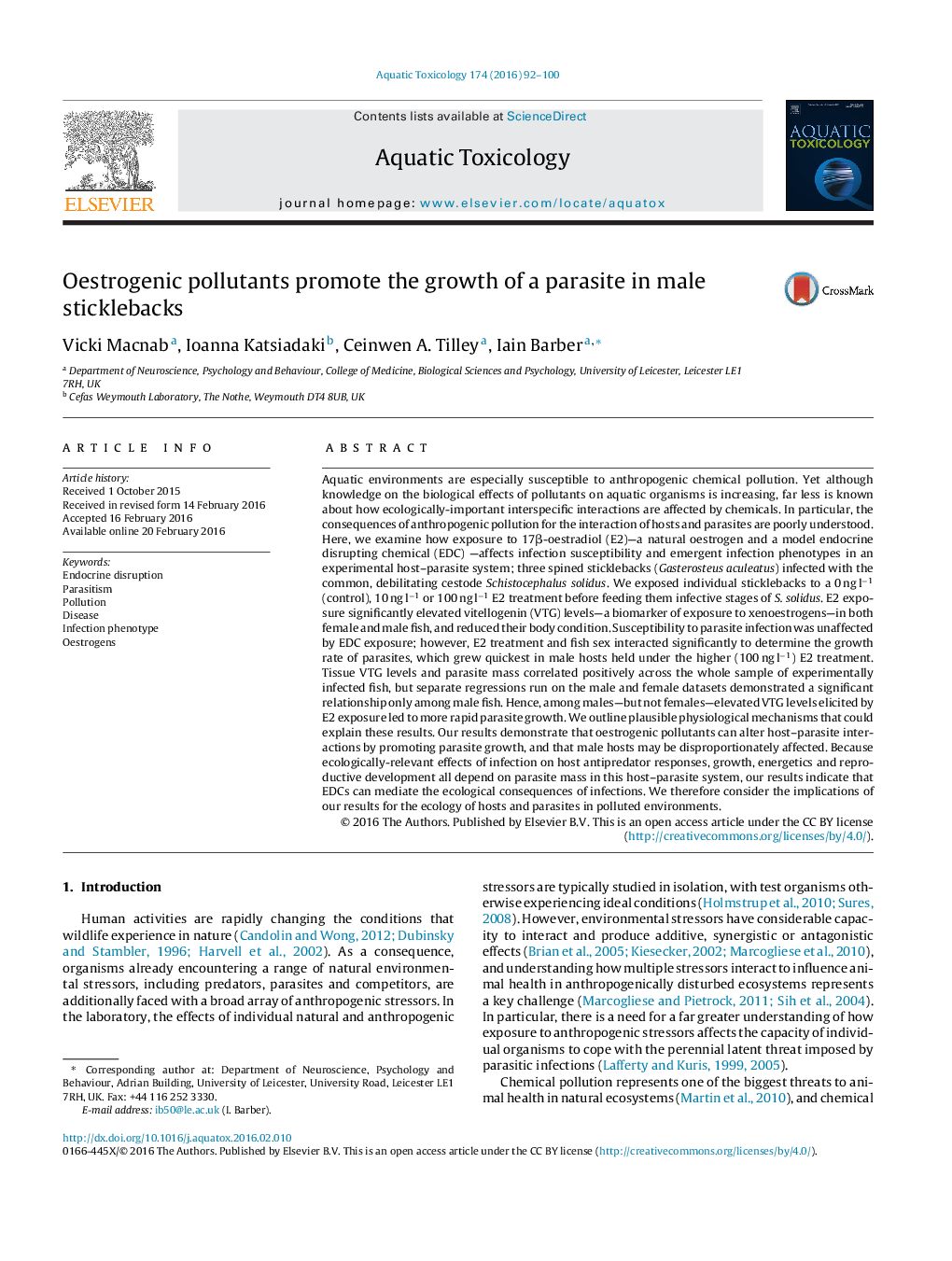| کد مقاله | کد نشریه | سال انتشار | مقاله انگلیسی | نسخه تمام متن |
|---|---|---|---|---|
| 6381899 | 1625931 | 2016 | 9 صفحه PDF | دانلود رایگان |
عنوان انگلیسی مقاله ISI
Oestrogenic pollutants promote the growth of a parasite in male sticklebacks
ترجمه فارسی عنوان
آلاینده های ایزوتوژن باعث رشد انگل در سوسک های کوچک مرد می شود
دانلود مقاله + سفارش ترجمه
دانلود مقاله ISI انگلیسی
رایگان برای ایرانیان
کلمات کلیدی
اختلال غدد درون ریز، پارازیتیسم، آلودگی، مرض، فنوتیپ عفونت، ادرارآور،
موضوعات مرتبط
علوم زیستی و بیوفناوری
علوم کشاورزی و بیولوژیک
علوم آبزیان
چکیده انگلیسی
Aquatic environments are especially susceptible to anthropogenic chemical pollution. Yet although knowledge on the biological effects of pollutants on aquatic organisms is increasing, far less is known about how ecologically-important interspecific interactions are affected by chemicals. In particular, the consequences of anthropogenic pollution for the interaction of hosts and parasites are poorly understood. Here, we examine how exposure to 17β-oestradiol (E2)-a natural oestrogen and a model endocrine disrupting chemical (EDC) -affects infection susceptibility and emergent infection phenotypes in an experimental host-parasite system; three spined sticklebacks (Gasterosteus aculeatus) infected with the common, debilitating cestode Schistocephalus solidus. We exposed individual sticklebacks to a 0 ng lâ1 (control), 10 ng lâ1 or 100 ng lâ1 E2 treatment before feeding them infective stages of S. solidus. E2 exposure significantly elevated vitellogenin (VTG) levels-a biomarker of exposure to xenoestrogens-in both female and male fish, and reduced their body condition. Susceptibility to parasite infection was unaffected by EDC exposure; however, E2 treatment and fish sex interacted significantly to determine the growth rate of parasites, which grew quickest in male hosts held under the higher (100 ng lâ1) E2 treatment. Tissue VTG levels and parasite mass correlated positively across the whole sample of experimentally infected fish, but separate regressions run on the male and female datasets demonstrated a significant relationship only among male fish. Hence, among males-but not females-elevated VTG levels elicited by E2 exposure led to more rapid parasite growth. We outline plausible physiological mechanisms that could explain these results. Our results demonstrate that oestrogenic pollutants can alter host-parasite interactions by promoting parasite growth, and that male hosts may be disproportionately affected. Because ecologically-relevant effects of infection on host antipredator responses, growth, energetics and reproductive development all depend on parasite mass in this host-parasite system, our results indicate that EDCs can mediate the ecological consequences of infections. We therefore consider the implications of our results for the ecology of hosts and parasites in polluted environments.
ناشر
Database: Elsevier - ScienceDirect (ساینس دایرکت)
Journal: Aquatic Toxicology - Volume 174, May 2016, Pages 92-100
Journal: Aquatic Toxicology - Volume 174, May 2016, Pages 92-100
نویسندگان
Vicki Macnab, Ioanna Katsiadaki, Ceinwen A. Tilley, Iain Barber,
